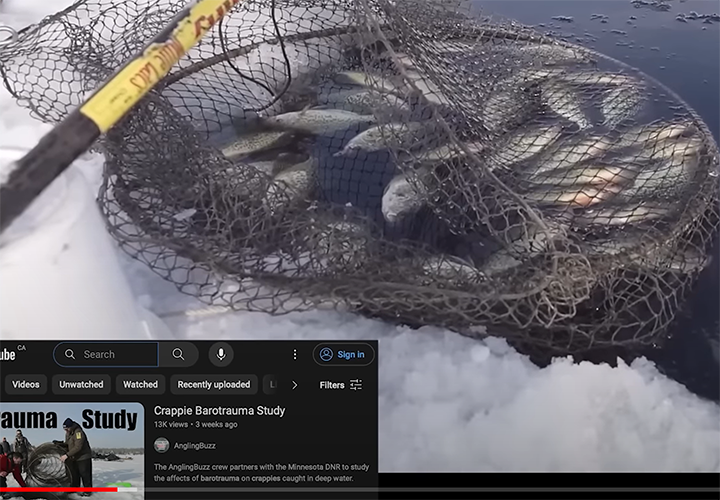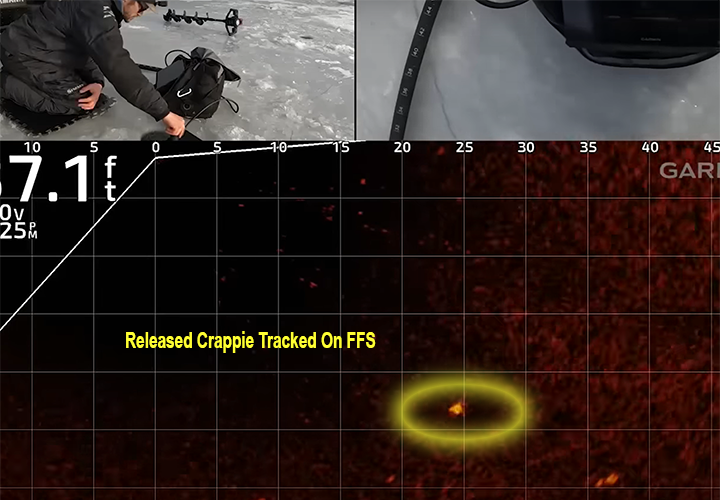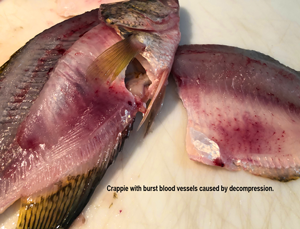
 Jeff Sundin January 4, 2024 Pointing Fingers Or Working It Out? — Releasing Crappies Caught In Deep Water, Who Proved What To Whom?
Jeff Sundin January 4, 2024 Pointing Fingers Or Working It Out? — Releasing Crappies Caught In Deep Water, Who Proved What To Whom?
 Ever since last week, when I shared the December 2023 Uncut Angling video of Aaron Wiebe challenging the “integrity” of the Lindner Media and MN DNR video about barotrauma, there’s been something bothering me. I feel like I should come down on somebody’s side and support them, but I can’t. There isn’t anybody who is clearly in the right, or in the wrong either. I’m conflicted because laying assumptions and opinions aside, nobody, me included, actually KNOWS for sure, what they’re talking about.
Ever since last week, when I shared the December 2023 Uncut Angling video of Aaron Wiebe challenging the “integrity” of the Lindner Media and MN DNR video about barotrauma, there’s been something bothering me. I feel like I should come down on somebody’s side and support them, but I can’t. There isn’t anybody who is clearly in the right, or in the wrong either. I’m conflicted because laying assumptions and opinions aside, nobody, me included, actually KNOWS for sure, what they’re talking about.
In case you missed it, the video produced by Uncut Angling host Aaron Wiebe accuses Minnesota’s DNR Fisheries Staff of purposely creating a flawed study. Wiebe’s assertion is that the project, a joint video production between the MN DNR and Lindner Media set out to “prove” their own preconceived notions about the effects of barotrauma on crappies caught in deep water. Wiebe claims that the holding nets used to observe released crappies, along with “improper handling” of released fish were responsible for the poor survival rate, not because they were caught in deep water.
Wiebe sets out to prove his theory by deliberately catching a dozen crappies in deep water, over 30 feet, and releasing them back into the wild. He offers as evidence video footage showing the fish on his forward-facing sonar as they swim back to the depths of the lake. Once the fish returned to the bottom, safely released, according to Wiebe.
Like I said, I do not know for sure what happens to every fish that’s caught and released in deep water. But when I first began writing about barotrauma back in about 2014, I asked every DNR biologist I could about the survival rates of barotrauma affected fish that were released in deep water, specifically depths over 30 feet. The consensus has always been that there are “some” fish that survive, most of them do not.
 Anecdotal accounts from ice tournament anglers have suggested a low survival rate too. Using underwater cameras during both pre-fishing and at tournament events, anglers reported seeing many deep waters caught fish lying dead on the bottom not long after being released. Lake home and cabin owners on popular, deep-water crappie fishing lakes also provided anecdotal reports of dead panfish washing up on shorelines during spring break up.
Anecdotal accounts from ice tournament anglers have suggested a low survival rate too. Using underwater cameras during both pre-fishing and at tournament events, anglers reported seeing many deep waters caught fish lying dead on the bottom not long after being released. Lake home and cabin owners on popular, deep-water crappie fishing lakes also provided anecdotal reports of dead panfish washing up on shorelines during spring break up.
Okay, so I may not know how many deep waters caught fish die, but I do know that it’s a significant number, and that brings me to a critically important point.
I do not believe that the MN DNR fisheries staff, Jeff Reed in particular, came at this study from the pre-conceived result perspective that Wiebe supposes. I singled out Jeff Reed because we have worked together on the “DNR Panfish Workgroup” for some time now and I know him. He has been nothing but honest and measured in his approach to learning about this subject.
In fact, I’ve personally heard Reed, on numerous occasions, caution folks against reading too much into the study, and acting too fast on its “suggested” results. Statements like, “These are only preliminary results, and we have a lot of work to do before we can be confident,” come immediately to mind, and there were others.
On the other hand, in Wiebe’s defense, I do agree that more “accurate” information is needed. And that there’s no scientific reason to further restrict angler freedoms until we have it. If his video does anything, it provides us with evidence that fish will swim away after being caught in the danger zone. The logical next step. I would think, is to tag those fish, track them and then report on their survival later in the season. Then we’d know for sure whether solutions could be provided through regulation, or if educating anglers is a better approach.
 Typical of posts found on “social” media, responses to Wiebe’s video were all over the map. Some were misguided, some were inaccurate, and some were downright nasty. But there are some thoughtful responses that I’d like to share with you.
Typical of posts found on “social” media, responses to Wiebe’s video were all over the map. Some were misguided, some were inaccurate, and some were downright nasty. But there are some thoughtful responses that I’d like to share with you.
David Weitzel, Assistant Regional Fisheries Manager | Northeast Region write; “The DNR study was initiated upon request of our Citizen’s workgroup who felt there was a need to get anglers to think and talk about how barotrauma impacts the fish, and how to fish more ethically. It seems that most agree that there is a greater mortality risk with deeply caught fish and anglers can reduce this risk by avoiding catch and release fishing at depths over 25 feet. We appreciated Uncut Angling’s views and willingness to continue the conversation about barotrauma.”
Unfortunately, Uncut Angling did not contact us prior to the video, so many of their concerns about the ongoing barotrauma study were based on assumption and the intent of the study was misrepresented. The Lindner video made it clear this was a pilot effort and incomplete, so we certainly acknowledge we have much more to learn but remain confident in the study’s overall design and our preliminary messaging to anglers. As far as the science goes, the video really didn’t point out any study weaknesses we hadn’t already discussed. It is important to note that the intent of the study was to determine the depth at which barotrauma becomes a concern and the pilot was not designed to literally determine mortality rates under typical angling conditions.
We appreciated Uncut Angling’s efforts to document fish being released from deep water. Unfortunately, simply tracking fish descent on a sonar is insufficient to understand mortality and fish must be held or tethered in a way that they can be later recovered to determine their fate. Just because a fish descends does not prove that they survive. The Uncut Angling video noted the air escaping the fish in the hole when held mouth up. Fish like trout, salmon and pike have a duct that connects their swim bladder to their stomach, allowing them to “burp” air to decompress their swim bladder as they are brought up from the depth, but crappie do not have this physical connection. The presence of air escaping suggests a rupture that would be lethal. We found this to be the case when we punctured the swim bladder by fizzing in our pilot efforts last winter. The fish initially swam down but died on the bottom due to a ruptured swim bladder.
We appreciate the efforts made by the angling media to cover this important topic and both videos suggest those conversations are ongoing, and we welcome them even if they point out challenges in the study design. We are hoping to get out on the ice to continue the study and are considering ways to evaluate some of the suggested release tips brought forth by Uncut Angling and others.”
Dave Allen, reader, and frequent contributor wrote, “Your article on (December 28, 2023) really did a number on me. So much so that I awoke at least 3 times overnight thinking about it. So, now I want to give you just a little MORE food for thought.
I watched the complete video twice and parts of it more. The one thing that kept entering my mind was how you have let some of your feelings about forward facing sonar units and Live scope be known and your, as well as my, reluctance to join the crowd and purchase one. I can't help but wonder if that could have been part of Mr. Lehrer's motive in sending you the link to the video.
As far as the subject matter of the video, it appeared to me that Mr. Wiebe has been catching and releasing DEEP CAUGHT crappie for some time and given quite a bit of thought to the matter. Either he might be on to something, or he is one heck of a SNAKE OIL salesman. So much so that the DNR should at least give his method of releasing DEEP CAUGHT crappie some consideration for testing his method.
We ALL know that everything we think we are seeing is not always what we're actually seeing. Nowhere in the video does it show above and below ice at the same time.
Let me close by thanking you again for all you do for the fishing industry in Minnesota. Keep up the hard and dedicated work. I always look forward to your fishing updates. Have a good one and I'll see you on the water.”
Dave Heck, reader and frequent contributor wrote, “Just wanted to share my opinion on Uncut Angling's barotrauma video.
He (Wiebe) has several valid points, especially on the handling of the fish after the catch and a quick release. The part in the video of the DNR's "scientific" study was probably the biggest eye opener for cause of concern. To me, that study should NOT be the basis from which they make their decisions. Too many things that were done incorrectly for it to be a valid study.
His video of the Live scope releases clearly indicates the need for more horizontal space to return slowly "except in the case of the smaller crappie" back to the bottom. As far as Wiebe's study is concerned the only missing factor is whether the fish died later after the release.
Teaching anglers his release technique and quick return to the water would be one of the most beneficial tools to consider. An idea I thought of for the DNR would be to select a small deep lake, close it off to anglers for the winter, catch and release a set number of fish throughout the winter, release them and track them back to the bottom using the Live scope technology, then monitor the number of fish found dead at ice out.
I do not own Live scope type technology. But I do believe it can be used by most to enhance their catch rate. Not all anglers have a conscious for doing things exactly legal but that is for the DNR to regulate. As for me, I know that when Side Imaging came along it enhanced my ability to find and catch more fish. But like anything you may be able to find them but that doesn't mean they're going to bite. I sat on top of a pile of crappies twice this fall and didn't raise but one or two to the surface. As you have indicated numerous times, education is the most viable source of conservation there is, but the information has GOT to be correct. Thanks for all your efforts and dedication to finding facts and truths. Happy New Year”, Dave Heck
![]() The process might not be pretty, but it’s good to see progress being made. When I began sharing reports about barotrauma it was hard to find folks who knew what it was. Now, almost everybody has at least heard of it, and many are taking action to minimize their impact on their favorite fishing lakes. Moving forward, it would make sense, I think, for Wiebe to team up with the DNR. Working together, they could craft studies that take us further down the path of learning what we should do, and what we shouldn’t do.
The process might not be pretty, but it’s good to see progress being made. When I began sharing reports about barotrauma it was hard to find folks who knew what it was. Now, almost everybody has at least heard of it, and many are taking action to minimize their impact on their favorite fishing lakes. Moving forward, it would make sense, I think, for Wiebe to team up with the DNR. Working together, they could craft studies that take us further down the path of learning what we should do, and what we shouldn’t do.
In the meantime, anglers would do well to notice THE COMMON THREAD that we all agree on. The message, consistently running through ALL of the articles, videos and “social” media posts about barotrauma is this. If we want to do what’s best for the fish, then we should avoid fishing for them in deep water. If we don’t have any choice, and deep water is the only place we can catch fish, then we should harvest the first ones we catch, and avoid releasing any. Then we should leave the area to enjoy some other fish species that live in shallower water. ![]() — Jeff Sundin 218-245-9858 or EMAIL
— Jeff Sundin 218-245-9858 or EMAIL
